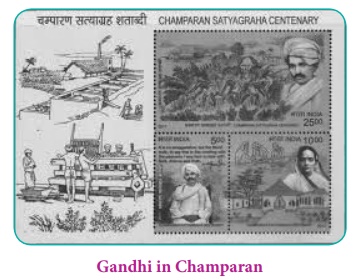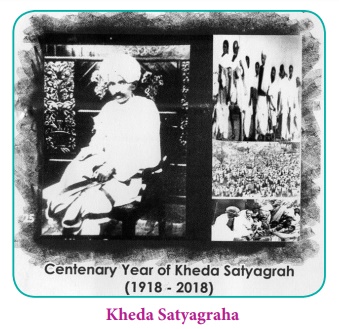Gandhi’s Experiments of Satyagraha
a) Champaran Movement (1917)
The first attempt at mobilizing the Indian masses was made by Gandhi on an invitation by peasants of Champaran. Before launching the struggle he made a detailed study of the situation. Indigo cultivators of the district Champaran in Bihar were severely exploited by the European planters who had bound the peasants to compulsorily grow indigo on lease on 3/20th of their fields and sell it at the rates fixed by the planters. This system squeezed the peasants and eventually reduced them to penury. Accompanied by local leaders such as Rajendra Prasad, Mazharul Huq, Acharya Kripalani and Mahadeva Desai, Gandhi conducted a detailed enquiry. The British officials ordered Gandhi to leave the district. But he refused and told the administration that he would defy the order because it was unjust and face the consequences.

Subsequently an enquiry committee with Gandhi also as a member was formed. It was not difficult for Gandhi to convince the committee of the difficulties of the poor peasants. The report was accepted and implemented resulting in the release of the indigo cultivators of the bondage of European planters who gradually had to withdraw from Champaran itself.
b) Mill Workers’ Strike and Gandhi’s Fast at Ahmedabad (1918)
Thus Gandhi met with his first success in his homeland. The struggle also enabled him to closely understand the condition of peasantry. The next step at mobilizing the masses was the workers of the urban centre, Ahmedabad. There was a dispute between the textile workers and the mill owners. He met both the parties and when the owners refused to accept the demands of the low paid workers, Gandhi advised them to go on strike demanding a 35 percent increase in their wages. To bolster the morale of the workers he went on fast. The worker’s strike and Gandhi’s fast ultimately forced the mill owners’ to concede the demand.
(c) The Kheda Struggle (1918)
The peasants of Kheda district, due to the failure of monsoon, were in distress. They had appealed to the colonial authorities for remission of land revenue during 1918. As per government’s famine code, in the event of crop yield being under 25 percent of the average the cultivators were entitled for total remission. But the authorities refused and harassed them demanding full payment. The Kheda peasants who were also battling the plague epidemic, high prices and famine approached the Servants of India Society, of which Gandhi was a member, for help. Gandhi, along with Vithalbhai Patel, intervened on behalf of the poor peasants and advised them to withhold payment and ‘fight unto death against such a spirit of vindictiveness and tyranny.’ Vallabhbhai Patel, a young lawyer and Indulal Yagnik joined Gandhi in the movement and urged the ryots to be firm. The government repression included attachment of crops, taking possession of the belongings of the ryots and their cattle and in some cases auctioning them.

The government authorities issued instructions that revenues shall be collected only from those ryots who could afford to pay. On learning about the same, Gandhi decided to withdraw the struggle.
The three struggles led by Gandhi, demonstrated that he had understood where the Indian nation lay. It was the poor peasants and workers of all classes and castes, who constituted the pith and marrow of India, whose interests Gandhi espoused in these struggles. He had confronted both the colonialist and Indian exploiters and by entering into dialogue with them, he had demonstrated that he was a leader who could mobilize the oppressed and at the same time negotiate with the oppressors. These virtues made him the man of the masses and soon he was hailed as the Mahatma.
Servants of India Society was founded by Gopal Krishna Gokhale in 1905 to unite and train Indians of different castes, regions and religions in welfare work. It was the first secular organization in the country to devote itself to the betterment of underprivileged, rural and tribal people. The members involved themselves in relief work, the promotion of literacy, and other social causes. Members would have to go through a five-year training period and agree to serve on modest salaries. The organization has its headquarters in Pune (Maharashtra) and notable branches in Chennai (Madras), Mumbai (Bombay), Allahabad and Nagpur.














